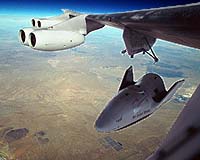
.
Posted on 12/18/2001 8:41:11 AM PST by RightWhale
X-38 Test Craft Completes Highest, Fastest, Longest Flight Yet
Houston - Dec 17, 2001
The X-38 prototype crew rescue vehicle successfully completed its highest, fastest and longest flight to date Thursday at NASA's Dryden Flight Research Center, a test flight that intersected some of the most critical conditions such a craft would experience when returning from space.
"The X-38 tests involve innovative technologies that will be useful for many future human spacecraft as well as a crew rescue vehicle," said X-38 Crew Return Vehicle (CRV) Program Manager John Muratore.
"Although the production of the crew rescue vehicle for the station is deferred, we are continuing to test and mature these technologies to reduce the technical and cost risk of a future CRV production program."
The landing test, the eighth large-scale flight test for the program, began with the release of the X-38 from NASA's B-52 aircraft at an altitude of 45,000 feet, more than a mile higher than any previous test.
During the test, the X-38 reached transonic speeds, velocities at the fringes of the sound barrier, as it flew free of the aircraft for almost a minute, descending three miles before its drogue parachute was deployed.
The drogue parachute slowed the vehicle from over 500 miles per hour to about 60 miles an hour, setting the stage for deployment of the 7,500-square-foot-parafoil wing. The X-38's parafoil is the largest parafoil ever built with a surface area more than one and a half times that of the wings of a 747 jumbo jet.
Descending under the parafoil, the X-38's proposed cockpit displays and controls were tested as an astronaut pilot remotely controlled portions of the craft's descent. Today's flight test also continued checkouts of European Space Agency-developed software that guides the parafoil, steering the X-38 to a safe landing.
After a 12-minute gliding descent, the uncrewed X-38 touched down at a speed of less than 40 miles an hour on the clay surface of Rogers Dry Lake on Edwards Air Force Base, CA.
Today's flight also successfully tested new X-38 flight control software modes specifically designed for a vehicle returning from space; improvements to the drogue parachute deployment; and enhancements to the parafoil's landing accuracy.
The test was the third X-38 mission using the parafoil sized for the actual space flight CRV. The test also was the third flight of an X-38 shape that includes a semicircular cross section aft end. The European-influenced semicircular aft end could allow the X-38 to be compatible with launch on expendable vehicles.
The X-38 project combines proven technologies -- a shape borrowed from a 1970s Air Force project -- with some of the most cutting-edge aerospace technology available today.
Although the United States has led the development of the X-38, international space agencies also are participating. Contributing countries include Germany, Belgium, Italy, The Netherlands, France, Spain, Sweden and Switzerland. NASA’s Johnson Space Center, Houston, Texas, leads the X-38 project and builds the test vehicles. NASA’s Dryden Flight Research Center flight tests the evolving X-38s.
"It's Space Daily to the rescue!! Fear not, fellow earthlings!!!!!"
...........................I need a vacation..........................
the crash of which, captured on film, was so dramatic it was incorporated into the intro of 'The Six Million dollar Man'?
DynaSoar. Air Force picked a winnning project name with that one.
They sometimes carry news of other [non-NASA] space programs. India, China, Japan, Nigeria, Oklahoma, N Kor, Iran, Israel, Euro, and the list is very long although NASA is still in the top 3 along with the US military and Russia.
That would be my guess as well, although I thought the DynaSoar project was more of a early 60's thing. The concept was well ahead of its time.
Interesting thing about the X-38 is that the lifting-body aspect is totally for re-entry and high speed aerodynamic flight. The actual landing is done with a parasail, and any reasonably flat cornfield will work as a "runway".

.

DynaSoar prototype, if it had actually gone into testing.
Good article and graphics, also an interesting website in general, Russians had a version in the planning as well.
Disclaimer: Opinions posted on Free Republic are those of the individual posters and do not necessarily represent the opinion of Free Republic or its management. All materials posted herein are protected by copyright law and the exemption for fair use of copyrighted works.